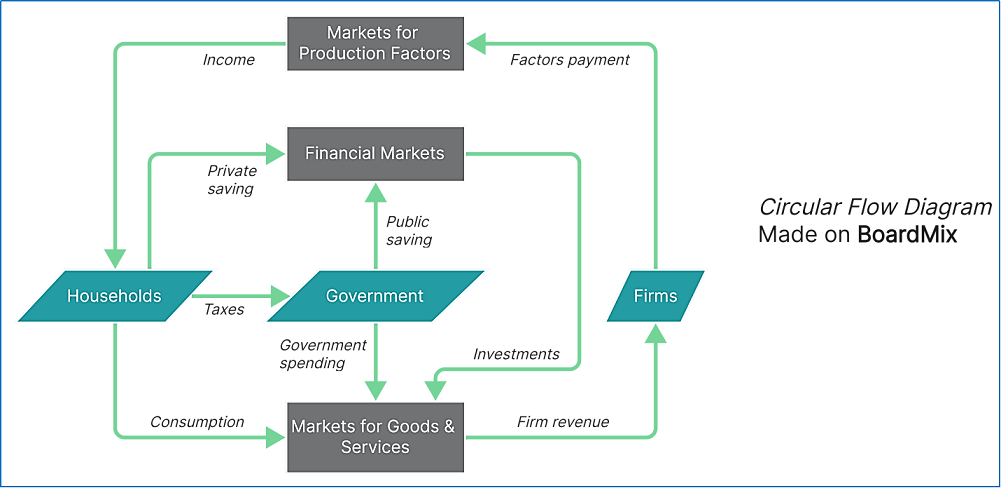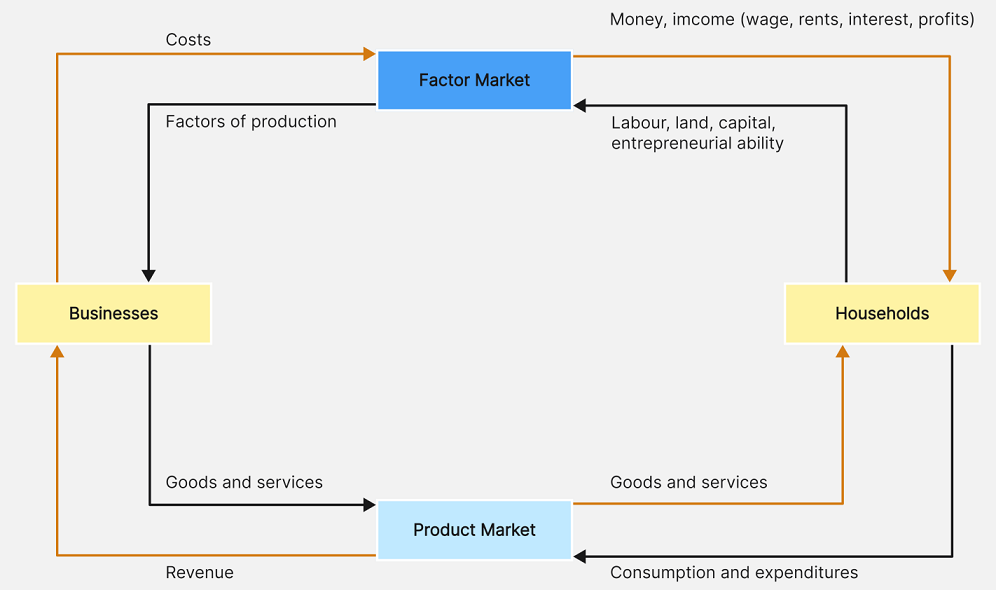The subject of economics is vast and full of complex theories, processes, and illustrations. One of the most popular visual instruments used in the field of economics is the circular flow diagram.
The circular flow chart is considered one of the central concepts modern economics stands upon. What we call macroeconomics, in particular, gives special significance to the circular flow of money and its visual representation.
This is why understanding this key concept will help you take a major step towards learning the major concepts of this field.
But don’t worry. Even if you’re not a student of economics, this article will help you easily understand what the circular flow diagram is and how you can create one online. We won’t be using the jargon economists are known for. So let’s dive straight into it.

Part 1. Learning about the Circular Flow Diagram
You might have a specific reason why you’ve been looking for material about the circular flow diagram. Perhaps you’re a student in the field or starting out a career in one of the many fields within economics and you’ve been assigned the task to create a circular flow diagram.
Or perhaps you’re just interested in the subject and want to learn more. After all, we should all know a little bit about how money circulates across the small and big systems within the economy.
1. What’s the Circular Flow Diagram?
The circular flow diagram illustrates how money moves through the complex network of relationships among key drivers of economic activity in a country’s economy. These economic drivers include the private sector, the government, families, service providers, manufacturing businesses, etc.
What this diagram shows is how everything in the economy runs in a cycle and keeps coming back to where it started.
The labor force across the world works on remuneration – daily wages, weekly stipends, monthly salaries, or on a per-project basis. At the completion of each wage period, these workers are paid their money, which they spend to purchase products and services they need. The products and services they buy are offered by the same companies and businesses where more workers are employed and paid money for their labor.
In short, money has a circular flow through the economy, which is what the circular flow diagram depicts.
Cicular Flow Diagram Example

2. What are the Common Types of the Circular Flow Diagram?
If you’re thinking we can use this type of charting technique to measure the circular flow of more than money, you’re right. Within the economy of a territory, country, or state, we can create a circular flow diagram to observe more than money.
In the field of economics, there are two key types of circular flows: that of money, which is aptly called monetary flow, and the flow of services and products recognized within that economy.
#1 MONETARY FLOW
The circular monetary flow is the cyclic movement of money. This circle begins with businesses – manufacturers and service providers – that employ workers and pay wages on a set schedule. That money is circulated back to these businesses as the workers use their salaries to buy commodities they need.
You can make several specific examples of this idea. For instance, you work for a leading manufacturer and drive to work in your car every morning. If you get a flat tire or something malfunctions in the car on the way to work one day, you will use the money your employer pays you to purchase services from a mechanic who will then use the money you paid him to buy groceries for his family.
#2 REAL FLOW
Real flow is all about the flow of commodities – products, and services alike – through the economy. This flow observes how labor bought from the workers by manufacturers and service providers leads to the production of goods and services across the economy.
The real flow is driven by various combinations of the economic drivers we mentioned earlier in this article.
Part 2. Impact of Using the Circular Flow Chart
The reason the circular flow chart is such a popular economic analysis instrument is due to the fact it comprehensively overviews the flow of money through a country’s economy. This information gives policymakers priceless insights into the health of the economy. It shows them how much money is being spent on purchases and how much wage is dispensed across the country. It tells them about the actual purchase power of the various social classes within the society.
We have learned from history that imbalances in the flow of money are a primary cause of economic crises. A lot of countries have lost financial stability because they started to spend more and generate less income.
That leads to diminishing volumes of money reaching the public/consumers, who then spend lesser money than before to purchase goods and services. That, in turn, has a negative impact on the economy as a whole.
This is why creating a circular flow diagram regularly can give policymakers hints on where the financial health of the nation is headed.
Part 3. Why Learn How to Use Circular Flow Diagrams
There are many reasons to learn how a circular flow diagram works:
- This one visual instrument can give you a very clear idea of the condition of your country’s economy at any given point in time.
- You can also learn about the specific ways in which your country’s economy generates money and how that money travels through the market in a circular motion.
- This information also gives you a vivid picture of how policymakers in your country are making laws, economic policies, and financial regulations.
Incidentally, with an online circular flow diagram maker, like Boardmix, you can easily create as many circular flow charts as you need.

Conclusion
To conclude, circular flow diagrams are a crucial instrument in economic reporting. These charts allow a country’s leadership to see where the money in the economy is coming from and how it circulates across the system.
As a student of economics or a concerned citizen, you can gain a lot from learning about both monetary and real circular flows. Also, you can create circular flow diagrams using online tools like Boardmix.








